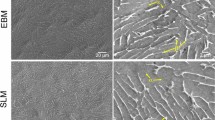Abstract
The microstructure and strength characteristics of the Ti–6Al–4V alloy prepared using the selective laser melting (SLM) method with different sample building geometry using an EOSINT M280 machine have been studied. It has been found that the hardness and elastic modulus (EIT) measured by the nanoindentation method depend on the sample built geometry. The sample that is built horizontally relative to the substrate has the highest hardness. The lowest hardness and elastic modulus (EIT) are observed in the sample grown at an angle of 30°. The residual internal tensile stresses and microstresses depending on the orientation of the sample relative to the built platform have been detected.






Similar content being viewed by others
REFERENCES
I. Van Zyl, I. Yadroitsava, and I. Yadroitsev, “Residual stress in Ti6Al4V objects produced by direct metal laser sintering,” South African J. Industr. Eng. 27 (4), 134–141 (2016).
E. Gordon and V. Dhokia, “Experimental framework for testing the finishing of additive parts,” Proc. 13th Int. Conf. Manufact. Research (ICMR2015) (2015), pp. 1–6.
I. Yadroitsev, P. Bertrand, and I. Smurov, “Parametric analysis of the selective laser melting process,” Appl. Surf. Sci. 253, 8064–8069 (2007).
M. Simonelli, Y. Y. Tse, and C. Tuck, “Effect of the build orientation on the mechanical properties and fracture modes of SLM Ti–6Al–4V,” Mater. Sci. Eng., A 616, 1–11 (2014).
P. Krakhmalev, G. Fredriksson, I. Yadroitsava, N. Kazantseva, A. Plessis Du, and I. Yadroitsev, “Deformation behavior and microstructure of Ti6Al4V manufactured by SLM,” Phys. Procedia 83,778–788 (2016).
N. Kazantseva, P. Krakhmalev, G. Fredriksson, N. Vinogradova, I. Yadroitsev, and I. Ezhov, “Twins in SLM Ti–6Al–4V alloys,” Titan, No. 2, 5–10 (2017).
M. V. Gerov, E. Yu. Vladislavskaya, V. F. Terent’ev, D. V. Prosvirnin, A. G. Kolmakov, and O. S. Antonova, “Investigation of fatigue strength of Ti–6Al–4V alloy obtained by selective laser melting method,” Deformatsiya i Razrushenie Materialov, No. 5, 14–20 (2016).
http://performancetitanium.com/astm-b265-6al-4v-eli- grade-23/.
http://www.yunchtitanium.com/ti-round-bar.
S. S. Gorelik, L. N. Rastorguev, and Yu. A. Skakov, X‑ray and Electron-Optical Analysis (Metallurgiya, Moscow, 1970).
V. M. Chernov, G. N. Ermolaev, and M. V. Leont’eva-Smirnova, “Impact toughness of EK-181 ferritic-martensitic chromium (12%) steel under loading by concentrated bending,” Tech. Phys. 55, 985–990 (2010).
Yu. I. Golovin, “Nanoindentation and mechanical properties of solids in submicrovolumes, thin near-surface layers, and films: A Review,” Phys. Solid State 50, 2205–2236 (2008).
GOST R 8.748-2011 (ISO 14577-1:2002) (Standart inform, Moscow, 2003) [in Russian].
N. Kazantseva, P. Krakhmalev, I. Yadroitsev, A. Fefelov, A. Merkushev, M. Ilyinikh, N. Vinogradova, I. Ezhov, and T. Kurennykh, “Oxygen and nitrogen concentrations in the Ti–6Al–4V alloy, manufactured by direct metal laser sintering (DMLS) process,” Mater. Lett. 209, 311–314 (2017).
L. Thijs, F. Verhaeghe, T. Craeghs, J. Van Humbeeck, and J.-P. Kruth, “A study of the microstructural evolution during selective laser melting of Ti–6Al–4V,” Acta Mater. 58, 3303–3312 (2010).
I. Yadroitsev, P. Krakhmalev, and I. Yadroitsava, “Selective laser melting of Ti6Al4V alloy for biomedical applications: Temperature monitoring and microstructural evolution,” J. Alloys Compd. 583, 404–409 (2014).
I. Yadroitsev and I. Yadroitsava, “Evaluation of residual stress in stainless steel 316L and Ti6Al4V samples produced by selective laser melting,” Virtual Phys. Prototyping. 10, 67–76 (2015).
S. P. Burkin, G. V. Shimov, and E. A. Andryukova, Residual Stresses in Metal Products (Izd-vo Ural. Un-ta, Ekaterinburg, 2015) [in Russian].
I. I. Novikov, Theoretical Principles of Heat Treatment in Metallurgy (Metallurgiya, Moscow, 1978).
C. Kenel, D. Grolimund, X. Li, E. Panepucci, V. A. Samson, D. Ferreira Sanchez, F. Marone, and C. Leinenbach, “In-situ investigation of phase transformations in Ti–6Al–4V under additive manufacturing conditions combining laser melting and high-speed micro-X-ray diffraction,” Sci. Rep. 7, 1–10 (2017).
G. Lütjering and J. C. Williams, Titanium (Springer, Berlin, 2007).
R. Pedersson, Microstructure and Phase Transformation of Ti–6Al–4V (Lulea University of Technology, Lulea, 2002).
B. A. Kolachev, V. I. Elagin, and V. A. Livanov, Metal Science and Heat Treatment of Non-Ferrous Metals and Alloys (MISIS, Moscow, 1999) [in Russian].
Y. Ming and Y. Peng, An overview of densification, microstructure and mechanical property of additively manufactured Ti–6Al–4V—Comparison among selective laser melting, electron beam melting, laser metal deposition and selective laser sintering, and with conventional powder, in Sintering Techniques of Materials, Ed. by A. Lakshmana (InTech, 2015) Ch. 5, pp. 77–106.
N. Kazantseva, P. Krakhmalev, I. Yadroitsev, A. Fefelov, N. Vinogradova, I. Ezhov, and T. Kurennykh, “Texture and twinning in selective laser melting Ti–6Al–4V alloys,” Int. J. Mater. Metall. Eng. 11, 723–726 (2017).
ACKNOWLEDGMENTS
The work was performed under the state task (theme Diagnostika, no. АААА-А18-118020690196-3; theme Davlenie, no. АААА-А18-118020190104-3) and was partly supported by the Russian Foundation for Basic Research (project no. 17-03-000-84). The studied samples were prepared at the Regional Engineering Center, Ural Federal University. Structural studies and nanoindentation were performed at the Centers of Collaborative Access, Mikheev Institute of Metal Physics, Ural Branch, Russian Academy of Sciences.
Author information
Authors and Affiliations
Corresponding author
Additional information
Translated by O. Golosova
Rights and permissions
About this article
Cite this article
Kazantseva, N.V., Ezhov, I.V., Vinogradova, N.I. et al. Effect of Built Geometry on the Microstructure and Strength Characteristics of the Ti–6Al–4V Alloy Prepared by the Selective Laser Melting. Phys. Metals Metallogr. 119, 1079–1086 (2018). https://doi.org/10.1134/S0031918X18110066
Received:
Accepted:
Published:
Issue Date:
DOI: https://doi.org/10.1134/S0031918X18110066




